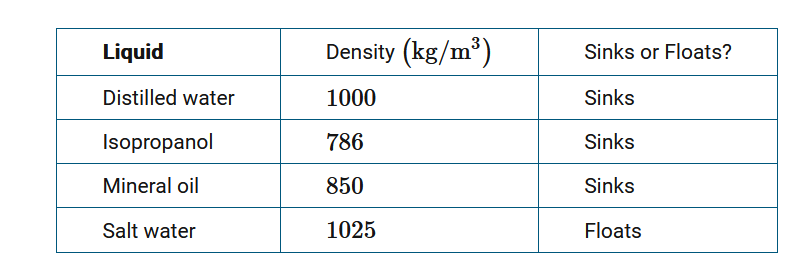Question

In an experiment, a student releases an object from rest in four different liquids and observes whether it floats. The results are listed in the table. Which of the following is true about the density of the object?
A It is greater than the density of each of the liquids.
B It is the same as the density of distilled water.
C It is between the density of distilled water and the density of salt water.
D It is less than the density of each of the liquids.
▶️Answer/Explanation
Ans:C
The object floats in salt water, so its density is less than that of the salt water. The object sinks in distilled water, which has the next greatest density, so its density is greater than that of distilled water.
Question
Students are investigating the change in the density of water as the temperature of the water increases. The students measure the mass and the volume of a quantity of water and then heat the water to various temperatures in the range using a thermometer to measure the temperature. They then attempt to determine the density of the water at the different temperatures. Assume any changes of equipment or measuring tools due to temperature changes are negligible. Which of the following methods would allow the students to obtain data from which they could determine the change in density of the water at different temperatures?
A Submerge a metal cylinder of known density in the water. Record precise measurements of the change in volume of the water due to the cylinder.
B Record the mass of the water and precise measurements of the volume of the water.
C Record the temperature of the water and precise measurements of the volume of the water.
D Record the temperature of the water and precise measurements of the mass of the water.
▶️Answer/Explanation
Ans:C
Because the water’s mass does not change, measuring the volume at different temperatures would allow students to be able to determine how the water’s temperature effects its density.
Question
A student wants to determine whether the density of a solid cube of copper will decrease as its temperature is increased without melting the cube. Graphing which of the following will allow the student to study this question?
A Temperature as a function of time
B Volume as a function of temperature
C Mass as a function of time
D Mass as a function of temperature
▶️Answer/Explanation
Ans:B
Density is mass divided by volume. Since the cube does not melt, no mass is lost and the cube’s density depends only on the volume. Therefore, any change in volume will correspond to a change in density, so graphing volume as a function of temperature will show if the density changes with temperature.
Question
A physics teacher gives a solid object to each student in her class. The objects are each made of the same material but have different shapes and sizes. The teacher asks the students to measure the mass and volume of their object and to work together to determine the density of the material from which the objects are made. Which of the following methods will give the best estimate of the material’s density?
A Each student divides the mass of the object by its volume and shares the results with the class. The class then computes the average of all the densities.
B Each student shares the mass and volume of their object with the class. The class then computes the average of the mass values and divides this by the average of the volume values.
C Each student shares the mass and volume of their object with the class. The class then creates a graph plotting mass as a function of volume, draws a best-fit line through the data, and uses the slope of the best-fit line as the density of the material.
D Each student shares the mass and volume of their object with the class. The class then creates a graph plotting mass as a function of volume, draws a best-fit line through the data, picks the data point closest to the line, and divides the mass for that point by its volume to compute the density of the material.
▶️Answer/Explanation
Ans:C
This procedure utilizes a line that comes closest to all of the data points. The slope of this line gives the ratio of mass divided by volume, which is density.
Question
Find the approximate minimum mass needed for a spherical ball with a 40 cm radius to sink in a liquid of density 1.4×103 kg/m3
(A) 37.5 kg (B) 375 kg (C) 3750 kg (D) 37500 kg
▶️Answer/Explanation
Ans:B
Solution: V of this ball is 4/3 π r3 = 4/3 π (0.4)3 = 0.2681 m3. For the ball to just sink, it is on the verge of floating, meaning the weight of the ball equals the buoyant force of the fully submerged ball.
mg = ρfl Vdisp g m (10) = 1400 (0.2681) (10) m = 375 kg
